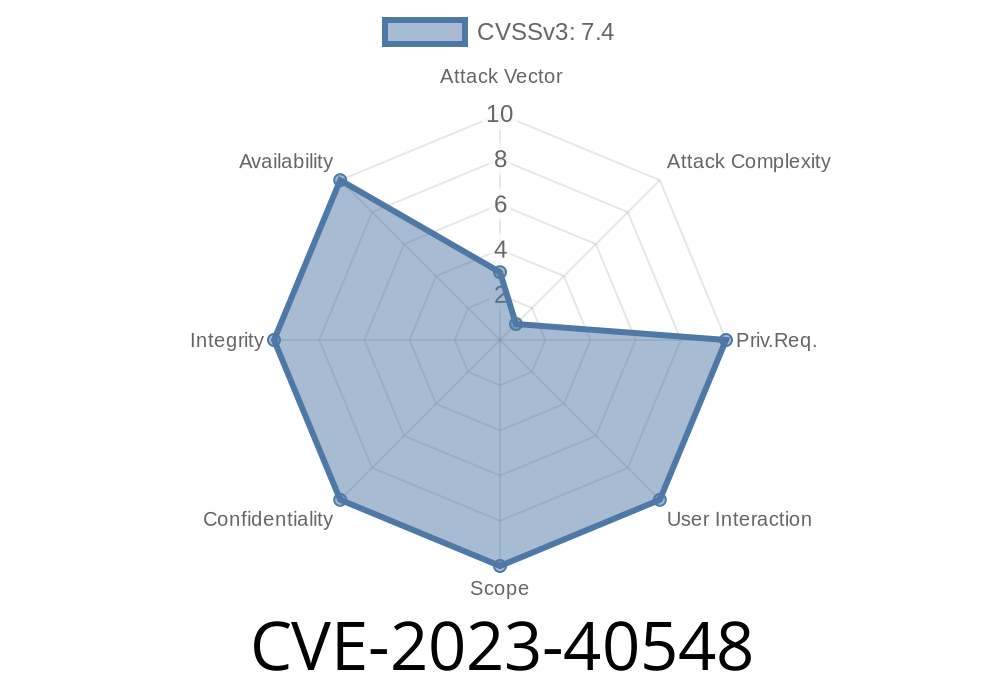A critical buffer overflow vulnerability has been discovered in Shim, specifically affecting 32-bit systems. The vulnerability, identified as CVE-2023-40548, occurs during an addition operation that involves a user-controlled value parsed from the Portable Executable (PE) binary used by Shim. This value is then used to carry out memory allocation operations, resulting in a heap-based buffer overflow. This flaw can cause memory corruption, crashing the system or leading to data integrity issues during the boot phase.
Description of the Vulnerability
In Shim, a bootloader for Linux systems installed on UEFI-based machines, an addition operation takes place involving a value that is controlled by the user and parsed from the PE binary. Due to the lack of proper validation, this user-controlled value can be manipulated to trigger a buffer overflow when the memory allocation operations take place, leading to heap-based memory corruption.
This vulnerability specifically affects 32-bit systems and can have severe consequences such as crashing the device or causing data integrity issues during the boot process. Not only does this flaw threaten the stability of the affected systems, but it also opens the door for attackers to exploit this vulnerability and potentially take control of the system.
Code Snippet Demonstrating the Vulnerability
/* vulnerable_function.c */
#include <stdint.h>
#include <stdlib.h>
#include <string.h>
#define USER_CONTROLLED_VALUE_SIZE 1024
void vulnerable_function(uint8_t *user_controlled_value) {
uint32_t total_size = ;
uint8_t *buffer;
// Parse and add user-controlled value
for (uint32_t i = ; i < USER_CONTROLLED_VALUE_SIZE; ++i) {
total_size += user_controlled_value[i];
}
// Allocate memory based on the manipulated total_size value
buffer = (uint8_t *)malloc(total_size);
// buffer overflow occurs if total_size is larger than expected
memcpy(buffer, user_controlled_value, total_size);
// ... rest of the function
// Free allocated memory
free(buffer);
}
Mitigation
To address this vulnerability, it is crucial to validate and sanitize the user-controlled value before performing the addition operation. This can be done through proper input validation and limiting the allowable size of the value to avoid buffer overflow.
The following code snippet demonstrates a possible fix for the vulnerability
/* fixed_function.c */
#include <stdint.h>
#include <stdlib.h>
#include <string.h>
#define USER_CONTROLLED_VALUE_SIZE 1024
#define MAX_VALUE_SIZE 256
void fixed_function(uint8_t *user_controlled_value) {
uint32_t total_size = ;
uint8_t *buffer;
// Parse and add user-controlled value with proper validation
for (uint32_t i = ; i < USER_CONTROLLED_VALUE_SIZE; ++i) {
if (total_size + user_controlled_value[i] > MAX_VALUE_SIZE) {
// Handle possible overflow
return;
}
total_size += user_controlled_value[i];
}
// Allocate memory based on the validated total_size value
buffer = (uint8_t *)malloc(total_size);
// The buffer overflow issue has been mitigated
memcpy(buffer, user_controlled_value, total_size);
// ... rest of the function
// Free allocated memory
free(buffer);
}
Original References
1. CVE-2023-40548 - National Vulnerability Database: https://nvd.nist.gov/vuln/detail/CVE-2023-40548
2. Shim Project on GitHub: https://github.com/rhboot/shim
Exploit Details
This vulnerability can be remotely exploited by an attacker, allowing them to manipulate the user-controlled value parsed from the PE binary to trigger a buffer overflow during memory allocation operations. By exploiting this flaw, an attacker could potentially gain control over the affected system, crash the device, or compromise data integrity during the boot phase.
In conclusion, the buffer overflow vulnerability in Shim (CVE-2023-40548) is a critical issue that affects 32-bit systems and can lead to severe consequences if left unaddressed. Proper validation and sanitization of the user-controlled value involved in the addition operation are crucial to mitigate this vulnerability and prevent potential exploitation by malicious actors. It is highly recommended for affected users to apply patches or follow the suggested mitigation techniques to secure their systems.
Timeline
Published on: 01/29/2024 15:15:08 UTC
Last modified on: 03/05/2024 20:43:45 UTC
